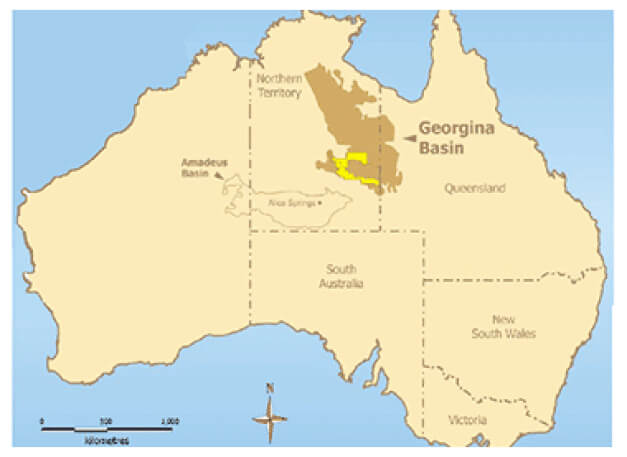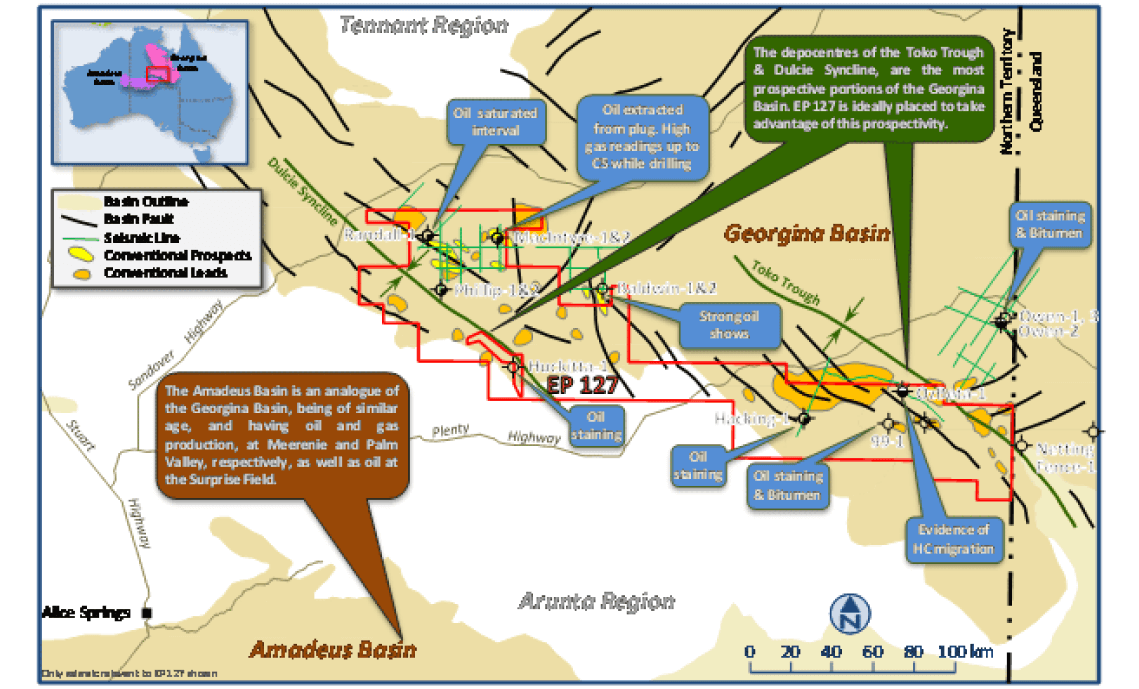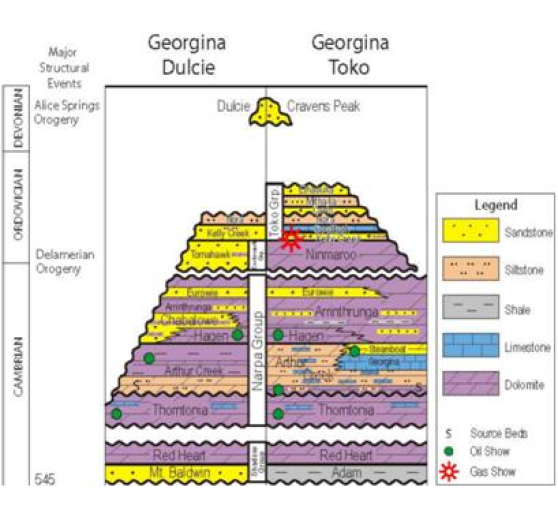
-
Project Overview
-
Global Oil & Gas Limited (ASX: GLV) headquartered in Subiaco, Western Australia holds an 100% interest in EP-127 located in the Southern Georgina Basin in the Northern Territory.
-

-
The Georgina basin is a region of proven oil potential and represents one of the few remaining virtually unexplored, hydrocarbon, and onshore sedimentary basins in the world. "The Southern Georgina Basin, onshore Australia, hosts high quality source beds and potential conventional and unconventional reservoir rocks. We believe that this basin is one of the most prospective onshore basins in Australia with potential for both very large conventional and unconventional oil and gas deposits.
-
The Basin covers more than 100,000 square kilometers (24.7 million acres) in the NT and western part of Queensland. Global Oil & Gas's Project Area, EP-127 is viewed to be the most prospective of the two permits due to it containing; the Dulcie Syncline and the Hagen Member which are considered to contain the most potential for conventional oil targets; the MacIntyre-2H well that produced high gas readings, prior to having been closed down due to nuisance levels of hydrogen sulphide (H2S); a portion of the Toko Syncline, reported as being highly prospective for conventional and unconventional oil and gas. " (Source: Ryder Scott). *The Ryder Scott Report can be found on the Reports and Presentations page of this website.
-

-
It is currently a sparsely explored green field area which makes up part of the Centralian Superbasin, comprising the Amadeus, Georgina and Wiso sub-basins. During the Cambrian era, the Central Australian plate was on the subtropical waters on the fringes of the Rodinia supercontinent. In this period, the organic-rich Arthur Creek black marine shales were deposited, particularly in the Dulcie and Toko troughs. Similar Cambrian marine shales are the source rocks in the extremely productive fields of East Siberia, Oman and the Tarim Basin in China. Above the Arthur Creek shales are the Thorntonia and Hagen Formations, both of which have been shown by previous drilling to show good reservoir properties and anhydrite seals. The Georgina Basin therefore has all the attributes of a productive hydrocarbon province. This prospectivity has been enhanced by oil shows in a number of wells, and gas flows to surface in the Ethabuka-1 and the Discovery Creek water bore.
Review Highlights
- As a result of industry and government work done to date it is clear; that the Toko Trough and the Dulcie Syncline, are the most prospective portions of the southern Georgina Basin and that EP 127 is ideally placed to take advantage of this relatively high prospectivity area of the basin.
- The conditions for conventional petroleum accumulations appear to be present in the southern Georgina Basin. The basin contains good source rocks, which have been thermally mature and have expelled oil and gas. Hydrocarbons have migrated through various porous reservoirs and sealing formations are evident in wells. Structural and combination structural/stratigraphic traps can be expected given the basins architecture. Although current seismic data coverage is poor.
- There appears to have been a historical miss-correlation of some of the prospective zones and possible bypassed pay zones. This new correlation has significant positive implications for geologic understanding of the basin.
- Several wells previously described as “dry holes” have untested; potential bypassed oil and gas pay zones which are conventional in nature. A number of conventional play types have been identified in the area.
The most prospective areas are likely to be where:
- Early formed structures, preferably basement related, or palaeogeographic reef-like or debris related mounds, with sealing shales or anhydrites providing both cross fault, top or draping seals;
- There has been a general lack of deformation and new faulting during the later phases of the Alice Springs Orogeny;
- Prospects are in relatively close proximity to depo-centres where favourable migration could occur form areas with prolonged oil maturity, and where;
- Suitable reservoir at a drillable depth, where porosity and permeability is either retained by early charge into the reservoir or enhanced by vugs or fractures.


HISTORICAL EXPLORATION - 1950'S to 1990's
Early exploration in the Georgina Basin consisted of stratigraphic holes or wells whose location was based on surface geological mapping. This included a number of wells drilled in the 1950s and 1960s, culminating in the Ethabuka-1 well in Queensland which recovered gas at 6,000 m3 per day (240,000 cfd) on test.
Subsequent drilling in the early 1980s was restricted to the stratigraphic drilling program undertaken by the Northern territory Geological Survey ("NTGS").
In the late 1980's to early 1990s, Pacific Oil and Gas explored areas in the Dulcie and Toko Synclines with the first serious attempt to acquire a regional seismic grid and drill wells based on its results. Some 750 kilometres seismic data were collected and 10 wells were drilled. The seismic lines were 5 to 30 kilometres apart, however most wells, recorded poor to moderate oil shows.

RECENT EXPLORATION - POST BARAKA ACQUISITION
The first drilling campaign carried out by Baraka and its Joint Venture Partner(The Operator), consisted of three horizontal wells that will require multi-stage fracturing & completion, one on Baraka's EP-127(MacIntyre-2) and two on the neighbouring tenements EP-103(Baldwin-2) and EP-104(Owen-3H) both owned by Baraka's joint venture partner. This Horizontal and multi-stage fraccing technology is a highly successful method widely used in North America to unlock unconventional reservoirs in oil shale zones in formations such as the Bakken formation. Baraka's management believes this was the first time such Technology had been utilized on Oil Shale in Australia. The use of Horizontal and Multi-Stage Fraccing stimulation technology enhances the possibility of a discovery by opening up hundreds of metres of potential pay zone.
MacIntyre-2H (EP-127)
-
October 2011
-
"MacIntyre-2" was drilled as a high angle pilot hole through the Basal Arthur Creek "Hot Shale" formation and into the Thorntonian carbonate formation. The inclined pilot hole well had been drilled to a measured depth ("MD") of 930 metres. Elevated hydrocarbon shows(C1 through C5) were recorded throughout the entire Basal Arthur Creek "Hot Shale" formation with sustained and high gas peak levels generally two to three times greater than those seen in the vertical pilot hole at Baldwin-2Hst1. In addition to the gas readings, of which some samples were effervescing, there was some evidence of oil on the samples.
-
The logging results for MacIntyre-2 were very positive showing approximately 22 metres of true vertical depth ("TVD") pay with porosities varying between 5 - 11%. Studies completed by two independent petrophysical companies indicated that the Arthur Creek "Hot Shale" zone in MacIntyre-2 may be oil bearing, although natural gas is present as well.
-
June 2012
-
Drilling of the horizontal section was re-commenced after the wet season subsided. MacIntyre-2H reached a total measured depth of 1,916 metres and stayed within the primary target zone, the Lower Arthur Creek "Hot Shale" Formation, for approximately 1,080 metres, recording positive hydrocarbon indications along the entire length of the horizontal section. A multistage open-hole completion string was placed in the well in preparation for a completion program.
-
October 2012
-
A successful hydraulic stimulation was performed on the MacIntyre-2H well over nine open-hole stages. However, after recovering approximately one-third of the hydraulic stimulation fluid, traces of biogenic hydrogen sulfide gas, produced from naturally occurring organisms in the completion fluid, were detected and the well had to be suspended.
Baldwin-2Hst1 (EP-103 : NOT Baraka's tenement)
-
Augest 2011
-
"Baldwin-2 Hst1" well reached a total measured depth ("MD") of 1,948 metres and remained within the main target zone in the Lower Arthur Creek "Hot Shale" for 875 metres while directionally drilling up a regional dip of 1.7 degrees. Positive hydrocarbon indications were recorded along the entire length of the horizontal section, with elevated gas readings and evidence of heavier hydrocarbons present. Total gas recorded in Baldwin-2Hst1 averaged 240 units over the entire horizontal section, commonly peaking above 1,000 units with maximum recorded values over 2,500 units.
-
The gas recorded contained heavier hydrocarbon fractions up to pentane ("C5") over much of the horizontal section. Conventional gas ratio analysis indicates very wet gas to oil for the most of the well with occasional definite oil signatures in places. However, this interpretation may be biased to gas due to the nature of the reservoir being intersected. A multistage open-hole completion string was placed in the well in preparation for a completion program.
-
October 2012,
-
During the hydraulic stimulation program of the Baldwin-2Hst1 well, a shallow casing failure occurred and as a result, The Operator was unable to complete the program. As expected, the multiple casing design protected the shallow aquifers.
Owen-3
(EP-104 : NOT Baraka's tenement)
-
Augest 2012
-
The vertical section of the "Owen-3" horizontal well was drilled to a measured depth of 1,180 metres. A total 32.5 metres of core was cut and retrieved from the Lower Arthur Creek "Hot Shale" and Thorntonia Carbonate formations. The initial assessment of the cores were very encouraging, seeping oil upon retrieval and having extensive florescence throughout. The well was also wire line logged with equally encouraging results indicating over 25 metres total vertical depth ("TVD") of hydrocarbon bearing formation. Total measured depth ("MD") of the Owen-3H well was 2,153 metres, of which the horizontal section was 966 metres targeting the Lower Arthur Creek "Hot Shale" and Thorntonia Carbonate formations.
-
Oil staining
Milky yellow fluorescing cut
Strong gas recordings of C1 to C5
Petroliferous odour
Oil spots in the mud at the shaker
-
A multistage open-hole completion string was placed in the well in preparation for a completion program.
-
October 2012,
-
A successful hydraulic stimulation was performed on the Owen-3H well over ten open-hole stages. Low fluid injection pressures and high injection rates evident during the stimulation were very encouraging. Log data and core samples had been obtained and appeared positive, confirming the existence of oil in the Lower Arthur Creek and Thorntonia Carbonate Formations. Like the MacIntyre-2H well, Owen-3H encountered nuisance levels of hydrogen sulphide in the initial flow back of the stimulation fluid. Hydrogen sulphide resistant testing equipment, along with a high capacity jet pump and all necessary surface tankage and piping were installed at the Owen-3H well so the cleanup and production testing could be conducted.
-
The Extended flow-test of the Owen-3H well will take up to 6 weeks depending on weather, equipment reliability and the nature of the recovered fluids. Results are expected some time prior to the end of the year(2012). These early stage results are encouraging and the flow-testing of the well are eagerly anticipated by all companies in the basin.
-
This data from all three wells will be used to guide the 2013 capital program as it supports the potential for oil recovery in the Southern Georgina Basins unconventional acreage.
JOINT VENTURE PARTNERS WITHDRAWAL - MARCH 2015
Petrofrontier and Statoil, as a result of not discovering hydrocarbons of sufficient quantity, quality or sufficient porosity from the limited wells drilled and completed, elected to withdraw from both permits, for their respective reasons.
Subsequently Baraka lodged, with the support of Petrofrontier and Statoil, an application for the renewal of EP127, is viewed to be the most prospective of the two permits due to it containing; the Dulcie Syncline and the Hagen Member which are considered to contain the most potential for conventional oil targets; the MacIntyre-2H well that produced high gas readings, prior to having been closed down due to nuisance levels of hydrogen sulphide (H2S); a portion of the Toko Syncline, reported as being highly prospective for conventional and unconventional oil and gas.

